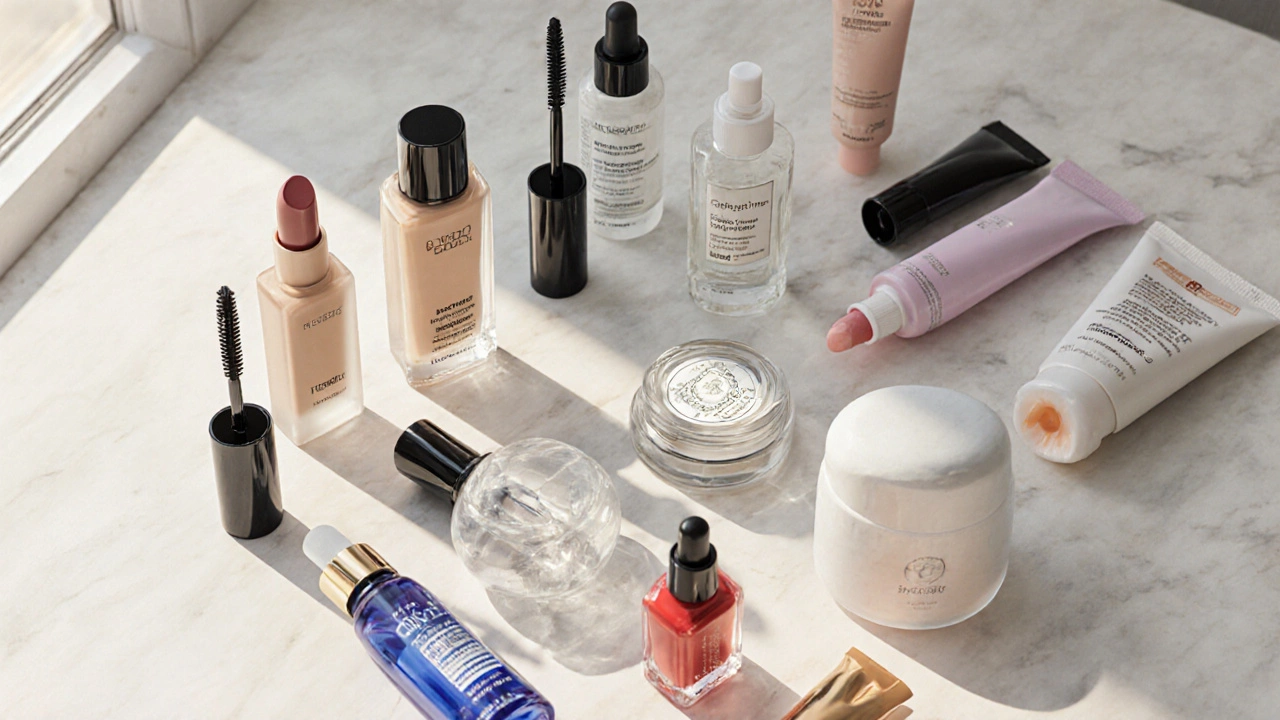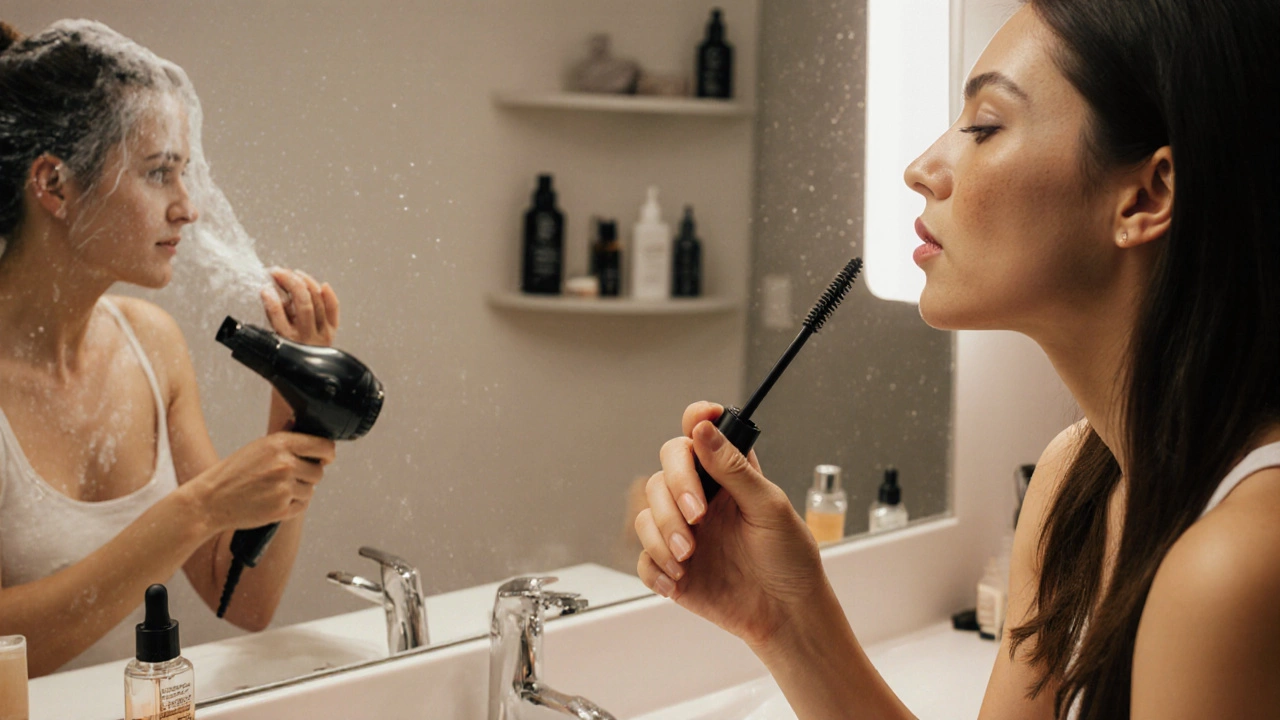
Skin Type & Concerns Matcher
Select your skin type and concerns to get personalized product recommendations based on the latest cosmetic science.
Your Personalized Recommendations
Quick Takeaways
- Cosmetic products cover anything you apply to your body for cleaning, beautifying, or altering appearance.
- They fall into major groups: makeup, skincare, hair care, fragrance, oral care, nail care, and sun protection.
- Each group has staple items - foundation for makeup, moisturizer for skin, shampoo for hair, etc.
- Regulation varies by region; in the U.S., the FDA oversees cosmetics, while the EU has stricter safety assessments.
- Choosing the right product means matching your skin/hair type, ingredient preferences, and any specific concerns.
What are Cosmetic Products?
When you hear the word "cosmetics," you probably picture lipstick or mascara, but the reality is far broader. Cosmetic products are any substances applied to the body for cleansing, beautifying, promoting attractiveness, or altering appearance without affecting the body's structure or functions. From the cleanser you use in the morning to the deodorant you spray after a workout, everything that sits on your skin or hair qualifies.
Major Categories and Everyday Examples
To make sense of the many items on the shelves, we can split cosmetics into a handful of well‑defined categories. Below is a quick snapshot of each group, the most common items you’ll find, and a typical use case.
| Category | Typical Example(s) | Key Benefit | Primary Regulating Body (US) |
|---|---|---|---|
| Makeup | Foundation, lipstick, mascara | Enhances facial features | FDA - Center for Food Safety and Applied Nutrition (CFSAN) |
| Skincare | Moisturizer, serum, facial cleanser | Improves texture, hydration, and barrier function | FDA - CFSAN |
| Hair Care | Shampoo, conditioner, hair serum | Clears scalp, strengthens strands, adds shine | FDA - CFSAN |
| Fragrance | Perfume, eau de toilette, body mist | Provides a pleasant scent | FDA - CFSAN |
| Oral Care | Toothpaste, mouthwash | Freshens breath, helps prevent decay | FDA - Center for Dental Products |
| Nail Care | Nail polish, cuticle oil | Colors nails, strengthens cuticles | FDA - CFSAN |
| Sun Protection | Sunscreen, SPF moisturizer | Protects skin from UV damage | FDA - Center for Devices and Radiological Health (CDRH) |

Deep Dive into Each Category
Makeup includes any product used to enhance or alter facial appearance. Foundation creates an even canvas, while eye shadow adds color to the lids. Lip products range from sheer tints to full‑coverage matte lipsticks. Many brands now offer mineral‑based foundations that double as light‑coverage sunscreen.
Skincare focuses on maintaining the health of the epidermis and dermis. A basic routine usually involves a cleanser, a moisturizer, and a targeted serum. Hyaluronic acid serums attract water to the skin, while retinol creams stimulate collagen production. Cleanser formulas vary: foaming gels work well for oily skin, whereas creamy cleansers suit dry or sensitive types.
Hair Care is split into cleansing, conditioning, and styling. Shampoos often contain surfactants like sodium laureth sulfate to remove sebum, but sulfate‑free options are popular for color‑treated hair. Conditioners add emollients such as dimethicone to smooth cuticles. For frizz control, many users turn to lightweight oils like argan or jojoba.
Fragrance is a blend of aromatic compounds dissolved in alcohol or oil. Eau de parfum typically contains 15‑20% fragrance oil, offering a longer‑lasting scent than eau de toilette (5‑15%). Niche fragrance houses experiment with rare ingredients like oud or ambergris, while mainstream brands focus on mass‑appeal notes like citrus and vanilla.
Oral Care products are technically cosmetics when they meet the definition of “intended for cleansing, freshening or altering the mouth.” Toothpaste formulas combine fluoride for cavity protection with mild abrasives for plaque removal. Mouthwashes may include essential oils for a fresh feeling, but alcohol‑free formulas are gentler on sensitive gums.
Nail Care encompasses polish, base/coats, and treatments. Modern polishes use urea‑free, low‑VOC (volatile organic compound) formulas to reduce allergic reactions. Cuticle oils often contain vitamin E and plant extracts that keep the nail matrix hydrated and less prone to split.
Sun Protection products are unique because they are regulated as both cosmetics and over‑the‑counter drugs. SPF (Sun Protection Factor) indicates how long skin can stay in the sun without burning compared to unprotected skin. Broad‑spectrum sunscreens protect against UVA and UVB rays, and ingredients like zinc oxide provide physical blockage.
How to Pick the Right Product for You
- Know Your Skin or Hair Type - oily, dry, combination, sensitive, curly, fine, etc. Products labeled “for oily skin” typically contain matte‑finishing agents, while “hydrating” formulas include humectants.
- Read the Ingredient List - Look for proven actives (e.g., niacinamide, ceramides) and avoid known irritants (e.g., fragrance, certain alcohols) if you have sensitivities.
- Check the Claims - “Non‑comedogenic” means it won’t clog pores, “hypoallergenic” suggests fewer allergens, but always verify with a patch test.
- Consider the Setting - Daytime foundation should have SPF, while evening makeup can be richer. Outdoor activities call for high‑SPF sunscreen.
- Budget vs. Performance - Drugstore brands often use the same active ingredients as high‑end lines but at lower concentrations. Decide what matters most: price, prestige, or specific technology.
Regulation and Safety: What You Should Know
In the United States, the FDA does not approve cosmetics before they hit the shelf, but it can take action against misbranded or unsafe products. Manufacturers must ensure their items are safe for intended use and list ingredients on the label. The EU’s Cosmetics Regulation (EC) No1223/2009 is stricter: every product needs a safety dossier and a “responsible person” who can be contacted for issues.
Key safety tips:
- Check expiration dates - many emulsions degrade after 12‑24 months.
- Avoid products that change color or smell unexpectedly; that often signals contamination.
- Do a 48‑hour patch test for new moisturizers or foundations, especially if you have eczema or rosacea.
DIY vs. Store‑Bought: When Does It Make Sense?
Homemade cosmetics, like a simple sugar scrub or a DIY lip balm, can be fun and cost‑effective. However, they lack the rigorous stability testing that commercial products undergo. If you’re looking for consistent SPF protection or long‑lasting pigments, it’s safer to stick with regulated brands.
That said, blending your own custom foundation mix (adding a drop of moisturizer to a powder formula) can solve specific texture issues. Just keep the batch small and store it in a clean, airtight container.
Common Pitfalls and How to Avoid Them
- Buying on impulse - A flashy package doesn’t guarantee performance. Read reviews and ingredient lists first.
- Over‑layering products - Stacking too many serums can cause pilling. Apply in order of lightest to heaviest texture.
- Ignoring skin/hair changes - Hormonal shifts can make a previously perfect product too heavy or too light. Re‑evaluate every season.
- Using expired items - Old mascara can harbor bacteria, leading to eye infections.
Frequently Asked Questions
What counts as a cosmetic product?
Any substance applied to the body for cleaning, beautifying, or changing appearance - from lipstick and shampoo to deodorant and sunscreen - fits the legal definition of a cosmetic.
Are sunscreens considered cosmetics?
Yes. In the U.S., sunscreens are regulated both as over‑the‑counter drugs and cosmetics because they protect skin while being applied topically.
How can I tell if a product is safe for sensitive skin?
Look for labels like “fragrance‑free,” “hypoallergenic,” and “non‑comedogenic.” Perform a 48‑hour patch test on a small area before full‑face use.
Do natural or organic cosmetics have fewer chemicals?
Not necessarily. “Natural” refers to ingredient source, not safety. Some plant extracts can be irritants. Always check the full ingredient list, not just the marketing claim.
Can I mix products from different categories (e.g., foundation with moisturizer) safely?
Generally yes, as long as the base formulas are compatible. Mixing a moisturizer into a powder foundation can improve wearability, but avoid combining products with conflicting active ingredients (e.g., retinol and strong acids in the same layer).